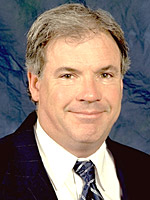
|

|

|
| This page is Bobby
Worldwide Approved for Section 508. |
|
 |
 |
 |

High Court OKs Extra Damages for
Cancer Fear
The 5-4 ruling in an asbestos
case could have implications for a broad range of litigation.
DAVID G. SAVAGE
Los Angeles Times
March 11, 2003
 Brent Rosenthal authored a TLPJ
amicus brief to the U.S. Supreme Court in support
of the right of severely injured people to sue for emotional
distress damages.
Brent Rosenthal authored a TLPJ
amicus brief to the U.S. Supreme Court in support
of the right of severely injured people to sue for emotional
distress damages. |
WASHINGTON -- Corporate America's asbestos
liability problem grew worse Monday, when the Supreme Court ruled
that a worker's fear of developing cancer can be the basis for
winning extra damages from his employer.
The 5-4 ruling came in a lawsuit against a railroad company, but the
logic of the court's decision will extend broadly, beyond even
asbestos cases, business experts said.
"This is not a good result for us," said Stephen Bokat,
general counsel for the U.S. Chamber of Commerce. "The fear of
cancer has arisen in lots of cases involving not just asbestos but
other toxic substances. We see this as opening a huge door with a
potential for very large damage awards."
But a Dallas lawyer representing asbestos victims downplayed the
decision. The notion that fear of cancer is enough for a worker
suffering from asbestos exposure to win additional money "has
become fairly well accepted in the state courts," Brent
Rosenthal said.
Paying for the damage caused by asbestos has spawned a new industry
in law and driven at least 57 companies to file for bankruptcy,
including 26 since Jan. 1, 2000.
Until the 1970s, asbestos was commonly used for fireproofing,
insulation and brake linings. By then, it had become clear that
inhaling the dust from asbestos fibers caused lung damage and
cancer.
|
Workers like those who had scarred lungs may recover "mental
anguish damages resulting from fear of developing cancer,"
Justice Ruth Bader Ginsburg said in Norfolk & Western Railroad
vs. Ayers. |
But the disease, like the liability problem, was slow to develop.
Workers exposed long ago are still filing asbestos claims. Employers
have looked to the high court for help, but their hopes have been
dashed on several occasions.
Citing a recent study by the Rand Institute for Civil Justice in
Santa Monica, the high court on Monday said that asbestos litigation
has consumed about $50 billion already and that the total cost may
exceed $200 billion.
The justices said Congress should pass new laws to cope with the
"elephantine mass of asbestos cases." In the meantime, the
court said, it will not change the ordinary rules of liability to
shield employers from paying injured workers.
The ruling upheld jury verdicts won by six retired railroad workers
in West Virginia who were exposed to asbestos on the job and
suffered scarring of their lungs. They said they feared they would
die of cancer.
Over the objections of the railroad's lawyer, the trial judge had
told the jurors they could award extra money to those workers who
"developed a reasonable fear of cancer that is related to a
proven physical injury from asbestos."
All six had asbestosis, a noncancerous scarring of the lungs. The
jury handed down awards of $770,000 to $1.2 million but didn't say
how much of the total was based on the plaintiffs' fears of
contracting cancer.
Six years ago, the high court ruled that "disease free"
workers who were exposed to asbestos cannot win damages simply for
their fear and emotional distress.
Last year, corporate lawyers were cheered when the Supreme Court
agreed to hear the railroad's appeal in the West Virginia case. The
U.S. Chamber of Commerce, the American Insurance Assn., the
Coalition for Asbestos Justice and the Bush administration joined
the case on the side of the railroad. They urged the court to rule
broadly that "emotional distress" cannot be the basis for
a damage verdict, even for workers whose lungs were scarred by
asbestos.
Instead, a narrow majority ruled Monday that under traditional
principles of liability, persons who suffer a true injury or disease
can seek extra compensation for "future harm genuinely
feared."
Workers like those who had scarred lungs may recover "mental
anguish damages resulting from fear of developing cancer,"
Justice Ruth Bader Ginsburg said in Norfolk & Western Railroad
vs. Ayers.
"Courts must resist pleas ... to reconfigure the established
liability rules because they do not serve to abate today's asbestos
litigation crisis," Ginsburg added. Her fellow liberals John
Paul Stevens and David H. Souter joined Ginsburg, as did
conservatives Antonin Scalia and Clarence Thomas.
Although the decision interpreted the federal law governing
railroads, the court's statement of liability principles will have a
broad effect, lawyers said.
"This case will be widely cited in the state courts,"
Bokat said.
In dissent, Justice Anthony M. Kennedy called Monday's ruling
"imprudent" because it will take money away from future
claimants who develop cancer. "Today's decision is not
employee-protecting; it is employee-threatening," he wrote.
In a separate dissent, Justice Stephen G. Breyer questioned the
awarding of damages based on "pure speculation" about the
emotional cost of fear and anguish. The fear may be real, but there
is no way to measure it in dollars, Breyer said.
Also dissenting were Chief Justice William H. Rehnquist and Justice
Sandra Day O'Connor.
Victor Schwartz, counsel for the Coalition for Asbestos Justice, was
disappointed by the outcome but said he was heartened that the
court's decision was confined to those who are "really
sick."
"It is virtually unprecedented for the court to call upon
Congress three times to fix a serious problem," Schwartz added.
Twice before, the justices have said the asbestos crisis requires
national legislation, but Congress has failed to agree on a formula
for resolving the problem.
|
 |
 |
